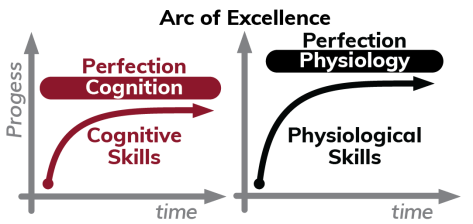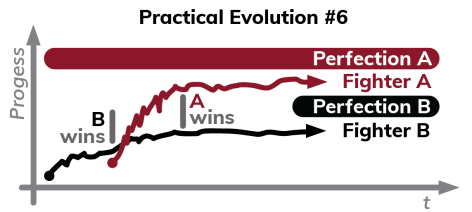![]() In academia, business, or sports the most ambitious in society strive to reach their maximum potential. But everyone has their limits in cognition, physiology, and the laws of physics. Humans are also bound by the constraints of body structure, genes, weight, and many environmental factors which limit speed, power, and accuracy. It’s important to be cognizant of strengths but just as important to recognize one’s weaknesses. Everyone can improve but ultimately cannot exceed their maximum potential. This is our reality.
In academia, business, or sports the most ambitious in society strive to reach their maximum potential. But everyone has their limits in cognition, physiology, and the laws of physics. Humans are also bound by the constraints of body structure, genes, weight, and many environmental factors which limit speed, power, and accuracy. It’s important to be cognizant of strengths but just as important to recognize one’s weaknesses. Everyone can improve but ultimately cannot exceed their maximum potential. This is our reality.
Each human has a unique journey towards perfection. This is best illustrated in the “Arc of Excellence” shown above. In mathematics, this is called a negative exponential curve, showing convergence to a certain limit, but reaching this limit occurs at infinity. In the context of fighting science, a student’s potential can be plotted against time. Each curve varies for cognitive and physical potential. The limits of individual perfection depend on fixed factors such as genes, physique, and talent. But the journey relies on variables that can be taught, such as confidence, persistence, grit, determination, drive, and willpower.
Although perfection is unachievable, what’s important is to recognize how to capitalize on one’s strengths while mitigating weaknesses. In any chosen discipline the goal is to get as close as possible to perfection, even if it can’t be reached completely.
Furthermore, a single training method suffers from the law of diminishing returns. This states that investing resources into a specific instance will not have the same incremental proportion of success. For example, 50 pushups per day will initially output dramatic results. Increasing to 500 pushups per day will be significant, but results will not be a proportional 10 fold increase. Likewise, 5000 pushups per day will not return proportional results against the time invested. It may be wiser to add ten different exercises that work on neighboring muscle groups or to focus on conditioning.
Each person’s potential curve is not smooth. Various factors can affect development such as training holidays or serious injury that results in extended periods of recovery.
The journey to perfection is also dependent on personal lifestyle, environmental surroundings, and training facilities. A trainer may take a student to an artificial maximum, based on their experience and teaching competence. But a student’s true potential may not be realized at that facility.
A student striving for perfection should recognize a club’s limitations and seek out new trainers who can take them to their true maximum. This is especially important for athletes seeking championship status. A few hops may be needed to recognize the diversity and effectiveness of various training methodologies and techniques. A major challenge is never knowing where is one’s perfection limit. A tangential change may surprise the athlete in realizing they had much more scope to their personal development.
Athletes differ in skill and follow their own unique journey along the Arc of Excellence. They may face each other in competition, at different stages of their development.
As shown in the figure above, Fighter B began training earlier than Fighter A but has a lower level of overall talent and potential. If they meet in competition when Fighter A begins training, then Fighter B will win. But once Fighter A’s potential is realized, he or she will quickly supersede Fighter B.
Martial Arts • Fighting Science Series
If you would like to read more articles in this “Yin Yang of Fighting Science” series, check out these posts:
• 1 • Yin Yang of Technique vs. Power
• 2 • Yin Yang of Speed vs. Timing
• 3 • Yin Yang of Fighting Styles
• 4 • Yin Yang of Technique vs. Instinct
• 5 • Yin Yang of Empty vs. Full Cups
• 6 • Yin Yang of Slow vs. Fast
• 7 • Yin Yang of Perception vs. Reality
• 8 • Yin Yang of Fear vs. Confidence
• 9 • Yin Yang of Threes
• 10 • Yin Yang of Burden vs. Privilege
• 11 • Yin Yang of Anticipation vs. Surprise
• 12 • Yin Yang of Compliance vs. Resistance
• 13 • Yin Yang of Attacking vs. Defending
• 14 • Yin Yang of Fighting 360°
• 15 • Yin Yang of Teachers vs. Students
• 16 • Yin Yang of Physics vs. Physiology
• 17 • Yin Yang of Vulnerability vs. Opportunity
• 18 • Yin Yang of Martial Arts vs. Combat
• 19 • Yin Yang of Sport vs. Violence
• 20 • Yin Yang of Rhythm vs. Random
• 21 • Yin Yang of Stability
• 22 • Yin Yang of Strategy vs. Tactics
• 23 • Yin Yang of Instinct vs. Reason
• 24 • Yin Yang of Unstoppable vs. Immovable
• Fighting Science • Fighter’s Curve
• Fighting Science • Fighting Zones








